Report

Executive Summary
- Retail ecosystems—vast, interconnected communities of consumers, retailers and partners—are becoming the norm in Asia, and will become an important part of the retail landscape in other markets in the years ahead.
- While retail ecosystems will take different forms and grow at different rates according to market characteristics, retailers face a host of decisions about whether—and how—to participate.
- We’ve identified the strategic options for retailers considering ecosystems and the factors that will help them choose the best approach.
Retail executives seeking to understand the future of retail should take a close look at Asia. It has the world’s highest rate of Internet shopping and the fastest growth in overall sales (see Figure 1). We expect around half of all retail growth will continue to come from Asia in the next five years.
China, South Korea, and increasingly India, are at the forefront of digitalization in retail

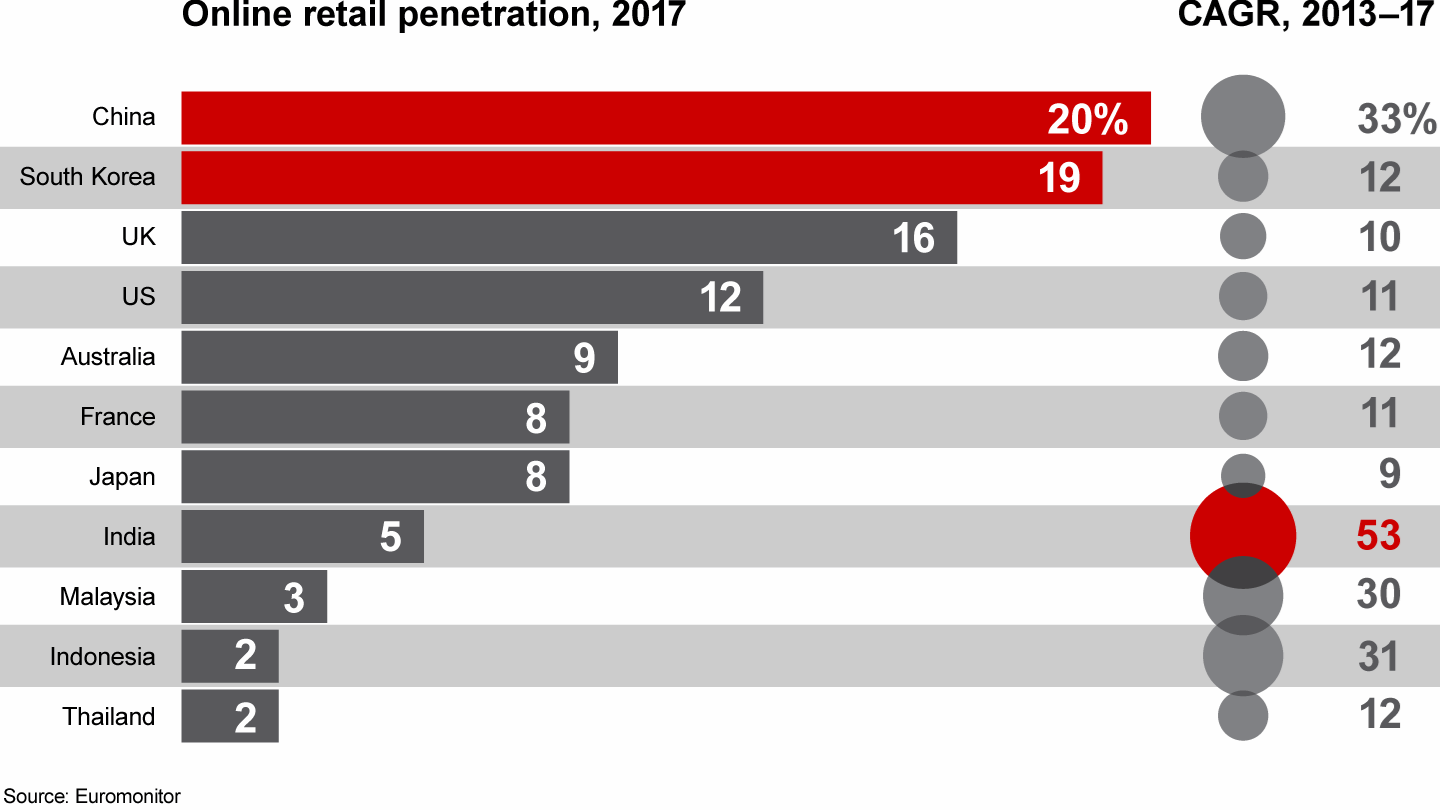
This boom has given birth to a concept with massive implications. Asia is home to the retail ecosystem: vast communities of consumers, retailers and partners that are rapidly reshaping the entire retail landscape, forcing retailers to just as quickly make some fundamental decisions.
Amazon may have launched the world’s first proprietary ecosystem, but the concept has so far generated its biggest momentum in China, where Alibaba and Tencent have within a few short years built open variants of the ecosystem—a one-stop shop for consumers and a powerful way for retailers to reach and serve millions of potential consumers.
Ecosystems start by combining a sticky set of consumer services like e-commerce, chat, streaming, gaming, booking services and payments in a single platform or app (see Figure 2). They attract a huge customer base, which in turn becomes incredibly attractive to retailers looking for easy access to a critical mass of consumers. A single, dramatic example: Tencent’s WeChat has one billion subscribers and is transforming the retail experience in partnership with JD.com.
Ecosystems benefit both shoppers and retail partners

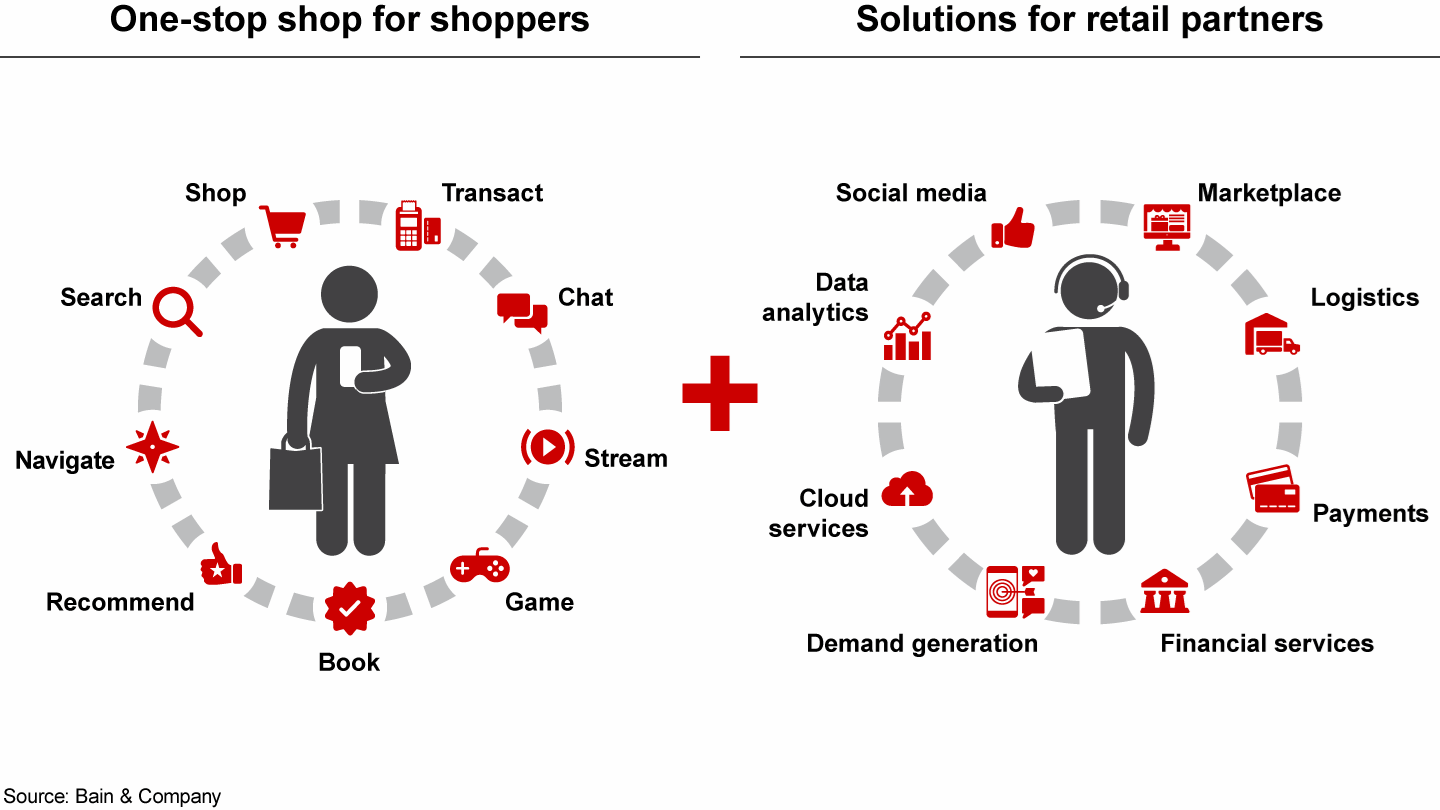
Plugging into an ecosystem also gives those retailers access to a host of hard-to-build capabilities, everything from rich customer data analytics to extensive logistics networks to cloud services. This can be a compelling and capital-light alternative to building and scaling their own capabilities.
The resulting scale achieved by ecosystem players provides both the capacity to reinvest and access to a new set of prized competitive advantages (see Figure 3). This, in turn, provides the basis for expansion into new services, new formats and new geographies—such as Alibaba’s entrance into travel services with Alitrip (since renamed Fliggy), its futuristic Hema supermarkets or its expansion into Southeast Asia by buying a controlling interest in Lazada.
A clear ecosystem formula can create both scale and hard-to-build capabilities

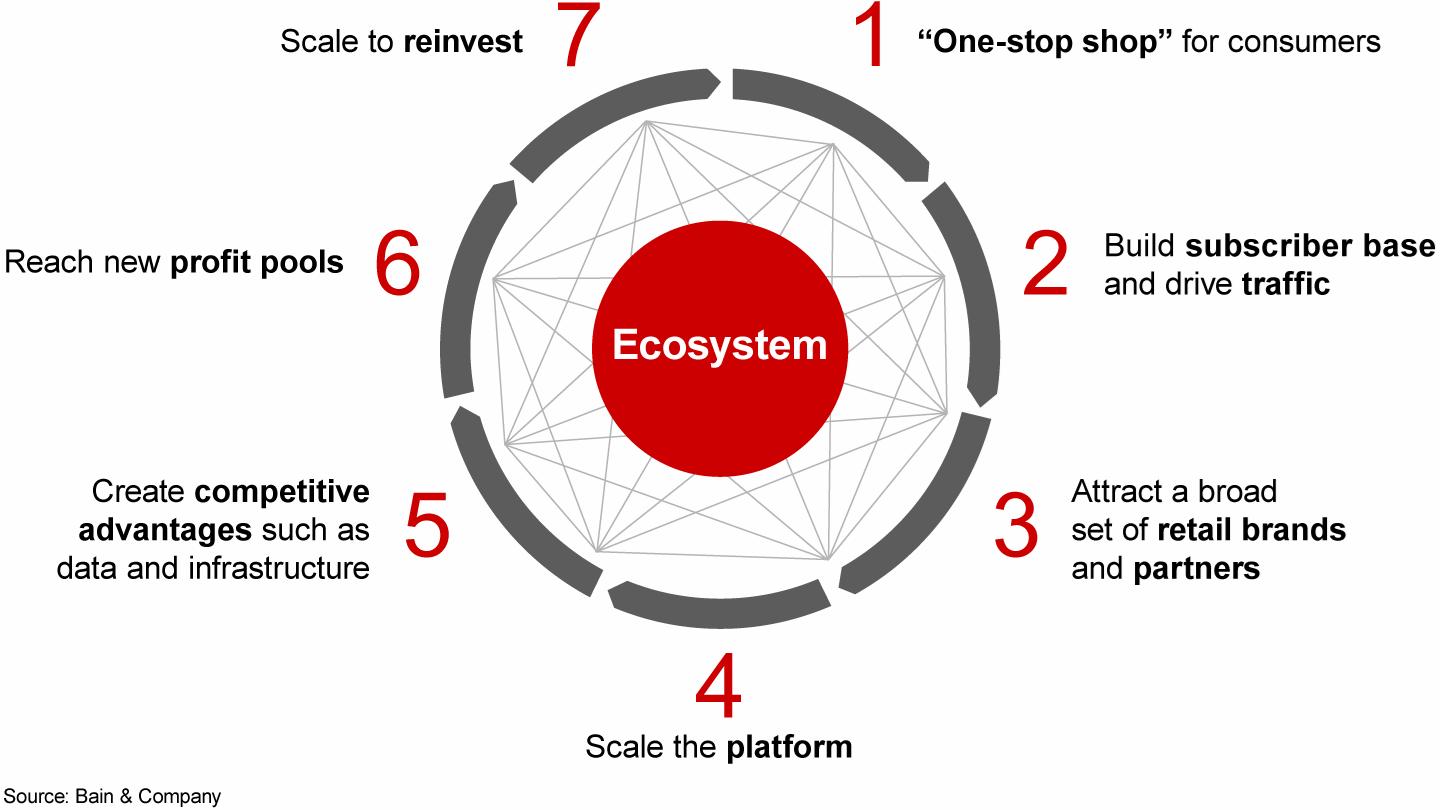
And it’s not a uniquely Chinese phenomenon. Retail ecosystems are emerging in India and South Korea, in the US and Europe, redefining consumer expectations and reshaping retail value chains.
As ecosystems build power, most retailers face a new set of choices. As we explain later in this report, participating in an ecosystem can provide some powerful advantages, but it also comes with some risks. So, do you build your own proprietary ecosystem? Do you join an open platform? Or, is the best answer to sell part of your company, as RT-Mart’s parent Sun Art did in China, or your entire company, as Whole Foods did in the US? At the heart of the decision: Do you have the capital, capabilities and customer franchise to compete against an ecosystem?
In addition, you must decide while keeping an eye on the regulatory environment, which will become more of an issue as ecosystems gain power, spurring governments to consider protectionist measures that support domestic companies in this global game.
Melanie Sanders, a partner with Bain's Retail practice, explains how retail ecosystems work and what companies can do to compete.
A natural progression
In many ways, ecosystems are a natural progression for Asia. The retailing landscape in China, India and the developing countries of Southeast Asia is highly fragmented, with relatively few stores per capita. These conditions were perfect for innovative digital insurgents like Alibaba and Tencent in China, Lazada in Southeast Asia and Flipkart in India to enter and disrupt, quickly meeting the consumer demands of a rising middle class.
For example, Alibaba came to life in 1999 as a website that helped small enterprises in China sell internationally. It then expanded via the creation of consumer-to-consumer (C2C) and business-to-consumer (B2C) marketplaces, such as Taobao, Tmall and AliExpress. This led to the creation of new businesses in payments, logistics and data analytics to serve the needs of consumers transacting on its marketplaces. Now Alibaba is extending its reach into offline retail through acquisitions and partnerships with local players, who benefit from its digital platform capabilities.
For its part, Tencent began as a social media site, and then systematically acquired all of the same pieces of the puzzle to become a retailing powerhouse. Through its stake in JD.com, for example, Tencent can leverage JD’s e-commerce services to offer a superior user experience and extend its presence in the fast-growing e-commerce market. Like Alibaba, JD.com offers its capabilities to offline retailers, through its retail-as-a-service business.
Amazon began as an online bookseller and now is not only the global leader in e-commerce, but has aggressively branched out into cloud services, media and entertainment, logistics services, business services, financial services and beyond. Again, all three of these ecosystems are actively integrating into bricks-and-mortar retail: Amazon with Whole Foods; Alibaba with RT-Mart, Ling Shou Tong, Intime; Tencent with Yonghui.

Asia’s Ecosystems and the Future of Retail
The market is quickly changing, providing challenges and opportunities for incumbent retailers.
Ecosystems vary by market
The evolution of retail ecosystems will not be uniform. Ecosystems will take different forms in different places. They will be more disruptive in some markets than others. They will develop faster in some markets than in others. Ten factors spanning country and retail market characteristics shape the growth trajectory of ecosystems (see Figure 4):
- Urban density
- Age of the population
- Smartphone penetration
- Delivery costs
- Logistics maturity
- Data regulatory environment
- Online trust concerns
- Prevalence of legacy bricks-and-mortar stores
- Scale and maturity of bricks-and-mortar retailers
- Scale and maturity of online retailers
Ten factors that predict the pace and path toward ecosystem retailing

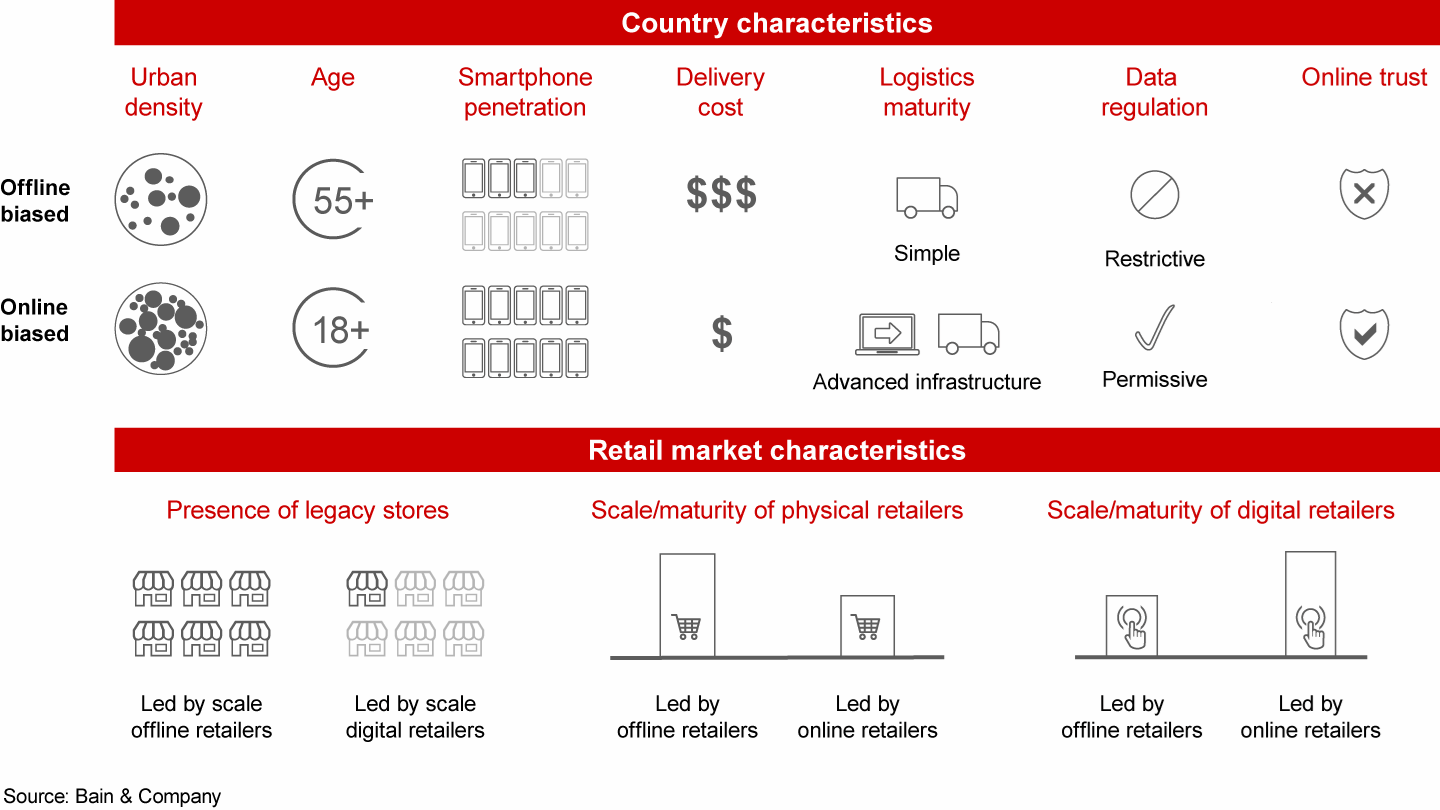
These 10 factors not only dictate the speed with which ecosystems will develop, but the types of ecosystems. We have identified four basic archetypes (see Figure 5).
Retail market conditions will determine the extent of ecosystem development

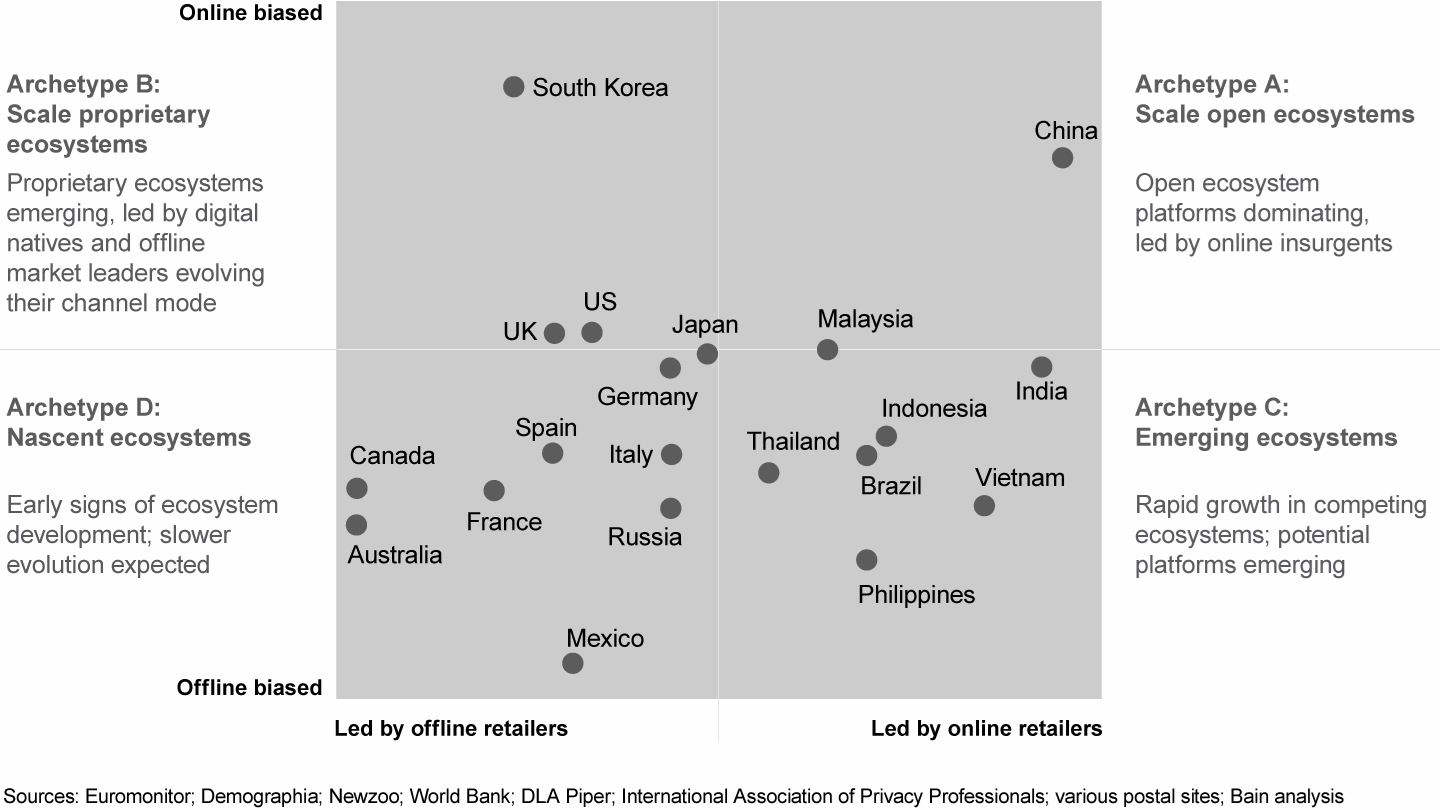
Scale open ecosystems. These massive ecosystems are open to all retailers as an alternative to building their own platform. Consider how thousands of retailers in China sell on Alibaba and Tencent, which compete head-to-head as the market’s leading ecosystems.
Scale open ecosystems thrive in markets that are ripe for digital disruption by scale insurgents. In these geographies, market factors create outsized opportunities for e-commerce. For example, there is a permissive environment for commercializing Big Data, attractive fulfillment economics and retail market structures that present low barriers to entry for digital insurgents. In markets that are conducive to scale open ecosystems, we are likely to see a winner-takes-all situation, with one or two leading players capturing most of the market. Any retailer hoping to ride the wave of growth will need to partner with one of those leaders.
Scale proprietary ecosystems. Proprietary ecosystems are not open to all retailers. Instead, they are built by a retailer that partners with other companies to provide services for its own customers only. These ecosystems grow more slowly than open ecosystems, and are typically formed by offline market leaders evolving their omnichannel models.
Consider the situation in South Korea, which, like the US and UK, exhibits many characteristics that spur online retail development. There is high urban density and a mature digital and logistics infrastructure. However, these markets also have scalable, installed bricks-and-mortar retail (South Korea’s five biggest grocers account for roughly 55% of modern trade grocery). They also have well-established companies leading in noncommerce online services, the way Facebook, WhatsApp or Netflix do in the US and UK.
Those entrenched businesses serve as a barrier to rapid digital disruption and lead to the development of proprietary systems. Unlike the winner-takes-all scenario of open ecosystems, we expect to see multiple ecosystem models in these markets, some originating from the evolution of omnichannel, and some created by online insurgents.
In South Korea, offline incumbents such as Emart built their strong omnichannel businesses while expanding in such areas as payments or marketplace models within their own ecosystem. Digital players like Kakao and Naver amassed mini-ecosystems around noncommerce customer touchpoints like social media, transportation, entertainment and search.
South Korea’s proprietary ecosystems could also be shaped gradually by offline incumbents teaming with digital partners. Yet, even if that happens, the landscape is likely to be less consolidated than China’s.
Emerging ecosystems. Countries like India and Indonesia lag in smartphone penetration and logistics infrastructure. As a result, their online retail penetration is relatively low. Yet, their lack of scale bricks-and-mortar retailers, combined with high density, means that they can potentially develop competing ecosystems rapidly as smartphone penetration, logistics networks and consumer trust in online shopping—a big issue in India—all improve. For example, India could see online retail grow 30% annually in the coming five years. As country conditions improve, developing markets in Asia most likely will follow the winner-takes-all path of scale open ecosystems.
India may leapfrog to a model of ecosystem development that will be similar to China’s, but much slower to form. It is one of the few markets where Walmart, Amazon, Alibaba and Tencent all compete and are actively investing in domestic partners. Walmart now owns 77% of Flipkart, while Tencent owns a small stake. Amazon competes directly and plans to buy a minority stake in the Future Group, complementing its investment in the More supermarket chain. Meanwhile, Alibaba has invested in several businesses, including Paytm and BigBasket. All are establishing ecosystems that will give them access to data that will help them lock in customers.
However, these multinationals must compete with domestic companies. For example, Reliance Industries, the $66 billion domestic conglomerate with businesses in telecom and retail, is a serious contender for market leadership in retail. As one of India’s largest offline retailers, Reliance is both cash rich (from its oil and gas assets) and experienced in disrupting markets. It recently gained ground with its fast-growing mobile service, Jio, which has more than 250 million subscribers, and is planning to boost its sales through an offline-to-online (O2O) marketplace.
Moreover, a series of government interventions could hurt multinationals’ chances in India. For example, complicated foreign direct-investment rules on online trading and inventory-based e-commerce may hold online back. India imposes regulations against overseas investment in multibrand retail and bans the international transfer of data generated by Indian e-commerce users. A similar Reserve Bank of India policy prohibits companies from sending financial data abroad; it is seen as a move to keep out foreign competition.
Nascent ecosystems. Countries like Australia and Japan exhibit a combination of characteristics that make them less favorable for ecosystem development. Those conditions may include low population density, an aging population or a mature bricks-and-mortar presence. Unless scale online insurgents emerge to spur rapid changes, retailers in these countries will likely become followers in omnichannel innovation, taking the path of scale proprietary ecosystems.
New rules of the game
As ecosystems become an important part of the retailing landscape, companies need to rethink the assumptions that have helped them grow in the past. The rules are changing (see Figure 6).
Emerging ecosystems change the rules of the retailing game

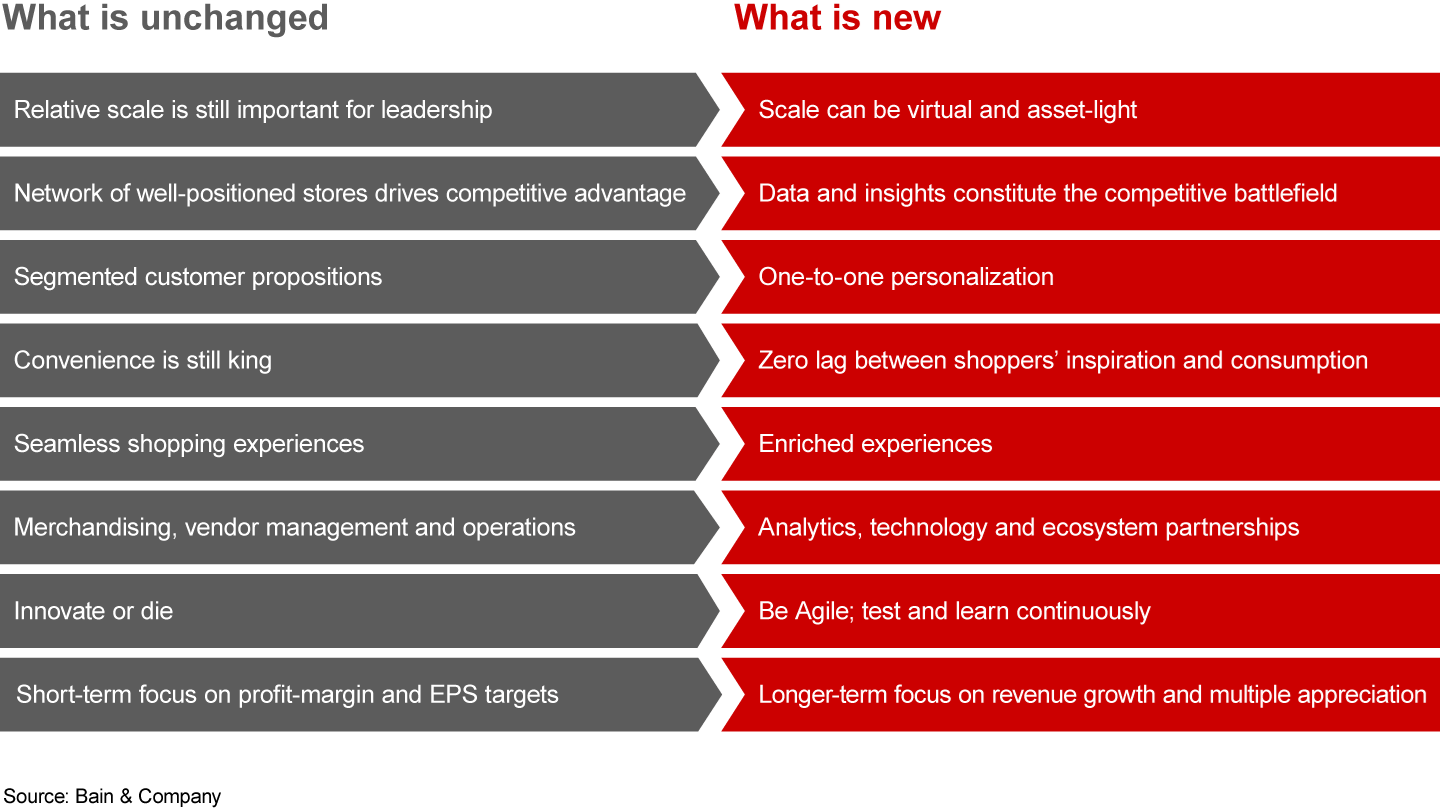
Rule 1. Relative scale has always been important for leadership economics … now scale can be virtual and asset-light. You no longer need to own the assets yourself; you can more easily plug into someone else’s platform. Consider how both Walmart and Yonghui joined with JD (and Tencent) to expand their last-mile delivery networks by using Dada-JD Daojia instead of building delivery networks from scratch.
Rule 2. A network of well-positioned stores still matters … but data and insights are the real competitive battlefields these days. The vast amounts of data generated each day on e-commerce, social media, payments and location-based services are a gold mine for retailers, which use it to generate insights that help create a personalized customer experience. Tencent’s family of businesses across social, commerce, entertainment, payment and gaming create a closed-loop view of consumer data, which enables Tencent to learn more completely about consumer beliefs, behavior and preferences. Tencent has indicated that it can label individual behavior with more than 5,000 discrete tags (such as what type of celebrities customers follow, what games they prefer, which news topics matter to them).
Rule 3. Segmented customer propositions are being replaced by one-to-one personalization. For years, retailers have grown by segmenting customers and offering them targeted value propositions. Now, advances in Big Data, machine learning and artificial intelligence make it possible to know more about each individual customer and offer a personalized assortment online. This approach increases click and conversion rates. Alibaba analyzes data from more than 600 million customers, using artificial intelligence to create personalized home pages and recommend products to customers.
Rule 4. Convenience is still king … but shoppers now expect zero lag between inspiration and consumption. Convenience matters more than ever. Online shoppers accustomed to instant access and instant results now want to be inspired by something online—seeing a dinner choice on the Hema app, for instance—and have it arrive at their door 30 minutes later (a service that Hema offers to shoppers living within three kilometers of its stores).
Rule 5. A retailer’s seamless omnichannel shopping experience (in its physical stores and e-commerce site) has been replaced by the seamless, rich and fun omnichannel experience across all ecosystem touchpoints. It is no longer sufficient to make it simple for consumers to find, buy and accept delivery of an item in an online-offline world. Now, retailers need to offer enriched experiences for multiple needs, such as social media and gaming, across the ecosystem. For example, Tencent’s ubiquitous all-in-one app, WeChat, is a hub for apps, services, information, entertainment and social connections, linking the online and physical worlds. WeChat consumers can message a friend to go to the movies, check the time of the movie, buy the tickets, order a taxi, buy popcorn, split the cost with the friend and reserve a restaurant table for the after-dinner movie—all within the same app. Or, consider how Pinduoduo allows shoppers to qualify for discounts by inviting WeChat friends to form a purchase group.
Rule 6. Merchandising, vendor management and operations still are essential … but now retailers need to build muscles for analytics, technology and managing ecosystem partnerships. Digital insurgents are quickly gaining ground by heavily investing in digital capabilities and aggressively hiring engineers. To remain competitive, incumbent retailers need to become equally ambitious—and make changes. For example, as they partner with digital businesses, they will need to learn how to manage those partnerships.
Rule 7. Leading retailers have long lived by the “innovate or die” mantra … now they have to do it quicker. With the rapid pace of change and the growing threat from digital insurgents, established retailers need to build a culture that allows for agility and continuous testing and learning to enter new categories and businesses that serve unmet customer needs.
Rule 8. Shareholders expect companies to meet short-term profit-margin and earnings-per-share targets ... now companies must manage shareholder expectations around a longer-term view of value creation. Investing to build digital capabilities can be capital-intensive and is likely to hurt profits until a retailer achieves scale. Short-term targets make it harder for incumbents to raise cash than digital insurgents, which are valued on expectations of exponential growth over a longer-term investment horizon.
So, how should retailers respond?
Standing still is not an option as offline customers move online in record numbers.
Fully 70% of the retail growth in the Asia-Pacific region from 2018 to 2020 will come from online sales. By not participating in e-commerce, retailers might not generate enough growth to offset cost inflation or maintain margins that already are under pressure due to online’s inherently more transparent pricing. This is playing out with the top five retailers’ EBIT dropping from 4.7% in 2014 to 3.5% in 2017.
However, making a big online push means investing more capex and opex, running the risk of cannibalizing channels and the near certainty of further reducing margins until the business reaches scale. In addition, the investments required just to keep pace with insurgents are sizable: digital insurgents’ invested capital is roughly 50% of sales, compared with 26% for incumbents.
When retailers consider the option of open ecosystems, they see both opportunities and threats. Open ecosystems give them access to rich data, new sources of traffic, marketing synergies, cost-effective logistics and a capex-light asset model. Yet, there are a host of significant threats, too, including the risk of disintermediation by the ecosystem’s own label and the loss of proprietary data. Also important: a retailer could lose control of its ability to set prices and the consumer experience itself.
What to do?
Go solo. Retailers can decide not to participate in an ecosystem but to focus instead on building their own differentiated and competitive omnichannel model. This option is most realistic for companies with access to capital, cost leadership, a compelling proposition and hard-to-replicate capabilities such as last-mile delivery (see Figure 7).
However, most will need to partner, and there are four basic choices for playing in ecosystems.
Incumbent retailers in Asia have five strategic options

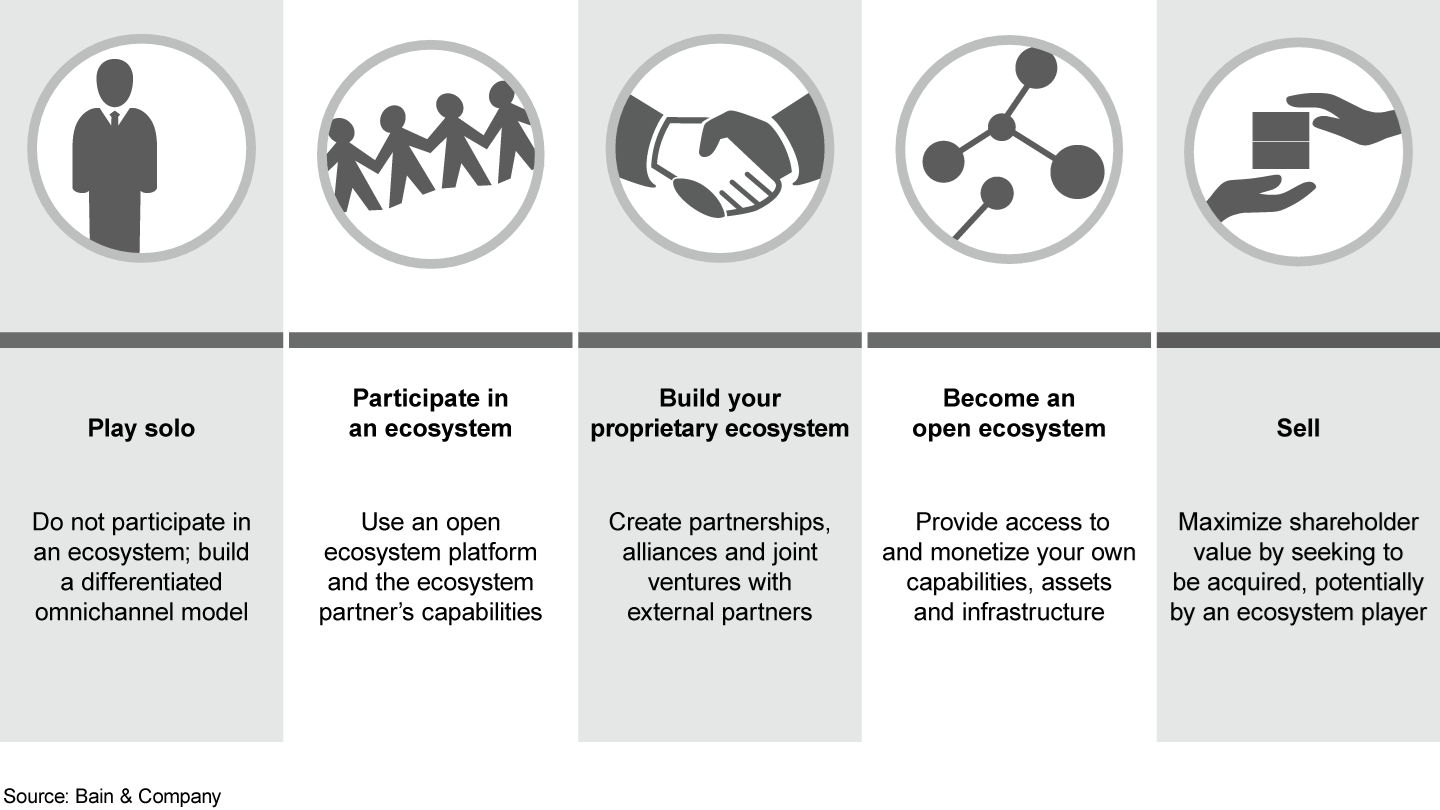
Participate in an open ecosystem. Walmart opted to join Tencent’s ecosystem and invest in JD.com, which enabled it to substantially boost its omnichannel capabilities and turbocharge its online growth. Roughly 200 Walmart stores are now connected to Dada-JD Daojia, an online commerce platform providing one-hour delivery service. The partnership also gives Walmart access to WeChat’s one billion users, and allows the retailer to integrate with WeChat’s payment platform and mini programs. Walmart partners with Tencent for digital capabilities such as pay-by-face recognition and Scan & Go, which improve both the customer experience and operating efficiency.
Build your proprietary ecosystem. Amazon may be the world’s largest proprietary ecosystem, but others are forming their own versions. South Korea’s Emart is an example of a retailer that built a proprietary ecosystem through partnerships, alliances and joint ventures with key external partners. The collaboration provides advanced digital capabilities. For example, Emart’s digitalized customer experience now includes an IM app directly linked to the stores, robot concierges, an integrated payment system and online-dedicated fulfillment centers supported by an in-house, proprietary logistics system. For its part, Australia’s Coles is in the early stage of constructing a proprietary ecosystem. Its partnerships include loyalty program Flybuys, which provides customer data, and MuviNow, which provides video streaming services.
Become the ecosystem open platform. Alibaba has systematically become China’s most recognized scale digital ecosystem, empowering all participants—consumers, retailers, brands, manufacturers, service providers—with its assets, data and insights, differentiation and efficiency.
Similarly, Tencent’s Internet-related products and services connect and enable online and offline players. For example, it has access not only to WeChat’s billion-member user base, but also to the social network’s Internet entertainment business and WeChat Pay, which processes 400 billion transactions each year. Tencent invests in and collaborates with online and offline retailers, including JD, Walmart, Yonghui and Xiaomi. As we mentioned, Walmart hopes to establish a similar integrated ecosystem in India, starting with its 77% stake in e-commerce leader Flipkart.
Sell. With retailing changing so drastically, sometimes the best option is to find the best way out: maximize shareholder value creation by looking for an acquirer, potentially an ecosystem player. Sun Art, parent of RT-Mart, China’s largest hypermarket, sold a 36% stake to Alibaba. Among the advantages: the sale helped RT-Mart transform its 400 stores with advanced digital technologies, including linking RT-Mart to Alibaba’s platform Taoxianda to integrate online and offline retailing with fast fulfillment capabilities.
As ecosystems become the dominant force throughout Asia, retailers have no choice but to assess their market characteristics and unique advantages, then decide on the smartest path ahead in a world that is too swiftly changing around them. In many ways, ecosystems have introduced a variant of musical chairs. There are only so many choices to make—and retailers need to make them before the music stops.
Checklist: How to choose a strategic option
What is the best next move? Here is a checklist for retailers evaluating their strategic options. The consequences of these choices are serious. And once in an ecosystem, it is difficult to leave.
- Is there a scale digital disrupter? A market with dominant ecosystem leaders is hard to penetrate. The best option might be to participate in their ecosystems or sell to them.
- Does the ecosystem offer a parenting advantage? A retailer whose assets are worth more to others can maximize its shareholder value by selling to the highest bidder or participating in an open ecosystem.
- Are there benefits to third-party scale? If additional scale through partnerships provides better economics, either join an ecosystem or build ecosystems (open or proprietary) to create “virtual” scale.
- Is the ecosystem not a competitor? It makes more sense to join an ecosystem when there is little to no risk of losing customers directly to that ecosystem.
- Is there cost leadership? Companies with an advantaged relative cost position may not need to join an ecosystem. For them, accessing the benefits of further scale can be less critical.
- Is there sufficient differentiation? Retailers with a compelling customer proposition that is difficult to replicate are more likely to be able to play solo and defend their position against the threat of an ecosystem.
- What are your omnichannel capabilities? Building omnichannel capabilities such as e-commerce, last-mile fulfillment, or data and analytics can require significant capital investment. Instead, retailers can access those capabilities by participating in either an open ecosystem, or a proprietary ecosystem through strategic partnerships or alliances.
- How much access to capital do you have? The capacity of a retailer’s balance sheet to fund new digital capabilities will dictate how much it can invest to future-proof its business. One capital-light option is to leverage the capabilities of an ecosystem partner.
- Are there privileged assets? Privileged assets, such as customer data or network reach and location, can help a retailer attract other participants to the ecosystem (both open and proprietary), provide defense against an ecosystem or make them attractive to an acquirer.
- What about customer stickiness? A value proposition that keeps people engaged, including high-frequency touchpoints, a strong loyalty program or highly attractive stores, can be a good starting point for building either an open or proprietary ecosystem platform. It also serves as a strong defense for retailers that decide to play solo.
Melanie Sanders is a Bain & Company partner based in Melbourne. Kanaiya Parekh is a Bain expert vice president based in Hong Kong. Hewie Kang is a partner in the firm’s Seoul and Shanghai offices. Marc-André Kamel leads Bain & Company’s Global Retail practice and is based in Paris. Jonathan Cheng is a principal in Hong Kong. All are members of Bain’s Retail practice.